The focus of office fit-out is increasingly on how digital systems as well as physical spaces can optimise the user experience. Aaron Little and Simon Rawlinson of Arcadis examine how best to realise the opportunities of smart technology when designing a workplace environment
01 / Introduction
A quiet revolution has been taking place in the UK office market. Behind high-tech facades, building systems have been getting increasingly smart – creating unprecedented opportunities for employers to interact with their staff and the workplace itself, using data to improve building management and enhance user experience.
Smart office buildings are also increasingly configured to share data with tenants. This gives occupiers much more control over their workplace environment as well as large volumes of management information.
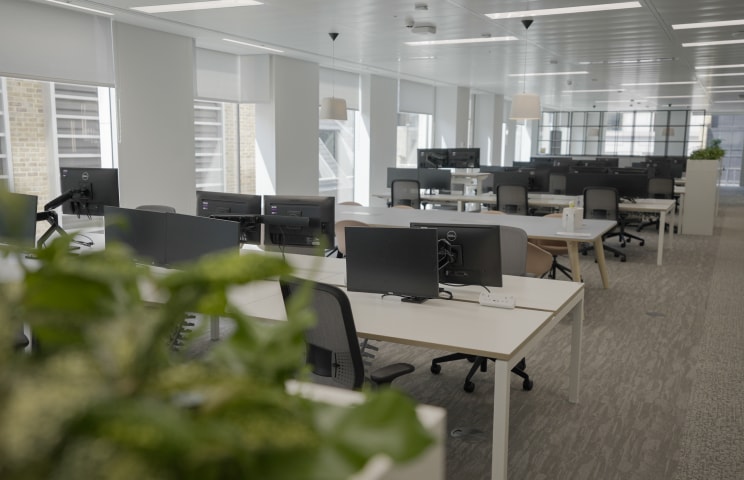
Covid has of course given the development of the digital office a huge boost. Lockdown has proven that a lot of work can be done productively at home. Looking forward, many employees will need a compelling reason to come into the office. Furthermore, the post-covid jobs market is incredibly competitive, with the UK’s ratio of vacancies to jobs at 4.3 per 100 – the highest since records began in 2001. Office-based sectors such as financial services, information and communications and professional services have above-average vacancy levels. In a highly competitive jobs market, a flexible workplace with dynamic work settings that give employees control is a clear source of competitive advantage.
The opportunity presented by relocation has also been transformed by the hybrid working revolution. Arcadis, for example, has pledged to reduce its global office footprint by 30% and is empowering employees to work in ways that best suit them. This personalisation of work style is fast becoming a critical aspect of employer brand. This means that many more issues need to be thought through as part of an office move, including how a business aims to support people as they alternate between working remotely and in the workplace, and how technology and systems can make this seamless.
Treating a relocation as a transformation journey can ensure that all opportunities associated with a physical move are realised. This article focuses on the key stages of the processes involved, to highlight how digital opportunities are changing the workplace conversation.
02 / Vision and business case
Ways of working have greatly changed over the past two years, so it is essential to have a current and relevant workplace vision. People, energy and property are the three biggest cost centres for office-based employers, and with the first two agendas now at the fore, a vision that places the workplace in the context of wider business strategy is critical.
For example, Arcadis’s global strategy is focused on achieving scale and collaboration, digital leadership and delivery of sustainable solutions. The workplace vision will support the strategy by ensuring that these ambitions can be seen and felt in the workplace, such as through user-friendly audiovisual technology and energy-efficient systems that support a peer-to-peer office culture.
At the level of the specific building, a more detailed vision is needed to describe the workplace look and feel and its functionality, and how this will represent change from existing practice. At a very early stage, well before a property has been identified, the focus will range from high-level principles, such as how people will use the space, to detailed considerations like the visitor journey from entrance to guest greeting, and what systems will be needed to support this.
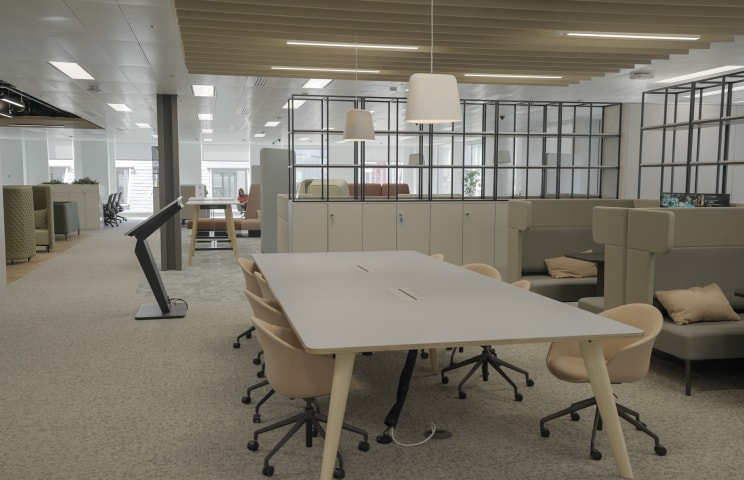
A digital workplace may include multiple types of workspace, from open-plan desks to collaborative and private workspaces or informal touchdown areas – there are 20 different types at the 80Fen building in the City of London’s Fenchurch Street
Workplace visions have to be ambitious because the status quo is not sustainable in terms of either user experience or space utilisation. Ultimately the ambition must be distilled into a business case, accounting for all the costs and benefits of the transformation. Post pandemic, workplace business cases are subject to more uncertainty due to unpredictable occupancy levels and highly variable data obtained from live workplaces. However, there are an increasing range of data sources across dimensions from occupancy levels and productivity to health-related absenteeism.
Forthcoming Arcadis research highlights potential savings of £3,000 per employee per annum based on a combination of energy, property and people cost savings. The business case sets the scene, enabling the hard work of transformation to proceed.
03 / How use case analysis supplements test fits in early-stage workplace design
Early-stage workplace design used to be focused on the test fit – in other words, confirming that a target office building can accommodate the workstations, meeting rooms and third spaces needed for the business. With a digital workplace, there is another element of early-stage design that is equally critical – the development of use cases.
Like the test fit, a use case is a foundation of workplace design, but it is concerned with precise instances of how the building and an occupant interact, as well as the technologies and spaces that will support these interactions. Use cases will include simple operations like desk, room and locker booking and more complex ones such as control interfaces in meeting rooms or data exchange links to base-build security systems.
Use cases are typically developed around a user journey, for instance a client visit, which will include interactions with the base building and tenant’s technology systems as well as the consideration of soft aspects such as in-person meet and greet and catering. All physical touch points and technology interactions associated with a user journey, including applications, data feeds and system interfaces, should be captured in the use case.
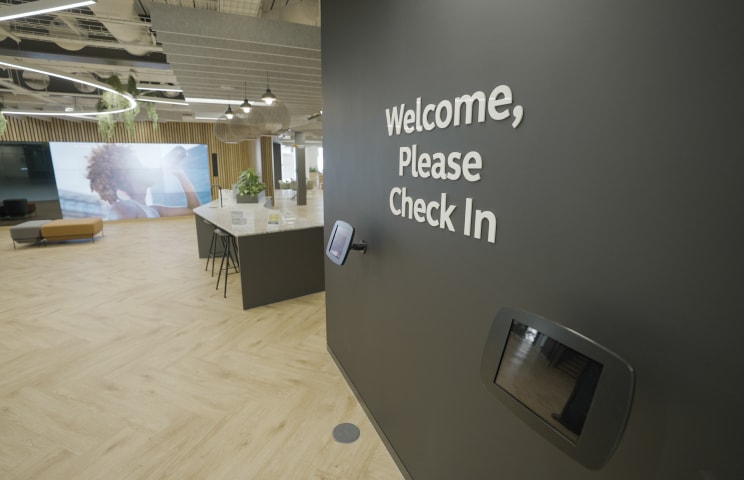
Planning out user journeys through the building is a key part of designing the systems and space of a digital workspace
A critical benefit of use case analysis is the identification of positive and negative experiences along the user journey. Use cases explore an ideal future state leveraging art-of-the-possible thinking, identifying the steps needed to get to the end-point without losing sight of the user experience. This removes the system vendors’ natural urge to force a specific technology solution onto a problem, and keeps the decision-making process focused on the value of the outcome.
The practical value of use cases for a digital workplace is that they create a comprehensive menu of digital requirements for the fit-out and they enable human-centric design thinking. Clients can clearly explain what systems they need with reference to the workplace benefits. This enables the definition and acquisition of products that support a specific functionality rather than the purchase of a generic system. As the solution is developed, use cases also support detailed system design by providing a framework for the identification of data inputs from landlord and tenant systems.
04 / Developing policy and rules for the workplace operation
User journeys and use cases are two examples of how the digital workplace requires a different approach to the definition and design of the workplace. As the design becomes more developed, further levels of detail are needed to define not only the products and systems but also how they will work in practice – what is often termed the business blueprint.
This blueprint demonstrates the relationship between physical and digital systems and the stakeholders who represent those systems. This means technology teams can take responsibility for delivering a system that links all the stakeholders together, delivering the desired experience outcomes.
Policies and data rules are the interfaces between the fit-out, digital systems and business systems like HR and enterprise resource planning systems (ERPs). As buildings and enterprises become more digitalised and are operated more flexibly, they need data rules to support automated decision-making. Policies are still very much focused on people, and the data rules provide the structure within which artificial intelligence (AI) systems can be trained.
Two examples of policies and data rules relate to meeting room usage and facilities management (FM) incident responses:
- The meeting room policies will be designed to encourage adoption of room-booking systems and to maximise the recycling of rooms when they are vacated. Data rules will determine whether audiovisual and room controls will work with or without a room booking and how long a room can be left vacant before being made available to other users. These data rules will be embedded in system interfaces and reflected in training materials that set expectations as to how space will be used.
- FM data rules link building systems and the service-level agreements set for responses to issues including technical problems, spillages and cleaning requests. By directing requests through systems, these can be automatically prioritised and tracked, and resulting data can be analysed to identify trends and corrective action.
These examples highlight the critical role that policies have in resetting workplace culture to align with new ways of working. Once again, the physical fabric of the fit-out is only one aspect of the workplace transformation. For example, automated lockers with a policy-based maximum reservation period can be used to discourage locker blocking. However, the reason for the change needs to be clearly explained. As businesses transition to hybrid working with greater levels of automation, policies and data rules will become increasingly important alongside the change programme that helps an organisation’s people understand and appreciate the benefits of the policies.
05 / Integration of technical solutions
Use cases describe and define the user experience outcomes that are required from the workplace so that the right set of products and solutions are incorporated into a fit-out. As use cases are translated into functional systems, integration methods for the stack of building systems are created. This means that clear paths are mapped out for how each control system will talk to IoT (internet of things) products, which in turn can pass data to a digital solution that might sit in the cloud. These methods allow the fit-out design to clearly determine how technology products can be procured, deployed and configured.
But what are the steps needed to get the products to talk to one another and to link up with the base build, and what are the challenges that need to be addressed? This is a critical area, as data capabilities are not yet standardised, and integration takes place on a project-by-project basis. Well-established standalone technologies like audiovisual systems do not require the same level of integration, so fit-out clients may be surprised by the effort required on some projects to interface with the base build systems. Repeat clients will gain advantages from lessons learned and an ability to iterate solutions across a project portfolio. However, for one-time clients some bespoke development is likely to be necessary as each project will present a myriad of unique integrations.
There are encouraging signs of some standardisation. For example, brand-new office developments are being specified with converged network systems (CNS) which both landlords and tenants can access. CNS is a digital infrastructure that facilitates the implementation of secure virtual networks on shared fibre, allowing occupiers to read and write data to building systems using application programming interfaces (APIs). CNS is an important enabler for integration, but there are further dependencies embedded in engineering systems including the data-sharing capability of the building management system (BMS) and the way base building systems are controlled.
The upshot is that, while digital products do increasingly work seamlessly as part of a digital workplace, there are plenty of sources of uncertainty that must be addressed as part of the delivery process. These include issues of data security, connectivity and data storage which need to be optimised so that system response times or latency considerations meet user expectations. This places a particular premium on the integration capabilities of the fit-out team and their ability to seamlessly connect to landlord systems.
Case study: Arcadis UK headquarters at 80Fen
The 80Fen building, in the City of London’s Fenchurch Street comprises 40,800ft² of flexible space across two floors, purpose-built around the needs and preferences of the staff who work there. The business objective of the move there was to create an environment that works for everyone, with an emphasis on sustainability, flexibility and choice, all enabled by technology. The fit-out supports activity-based working, with 20 different types of workspace, ranging from open-plan desks to collaborative and private workspaces to informal touchdown areas.
The base building has a wired score of Platinum, with networks that are configured to implement integrated building intelligence solutions. Smart features have been embedded as a key design principle, and the space is equipped with Arcadis’s own building intelligence product, capturing 1.85 million data points per day, which helps people find the right spaces for their tasks and monitors how the building is being used and how it is performing.
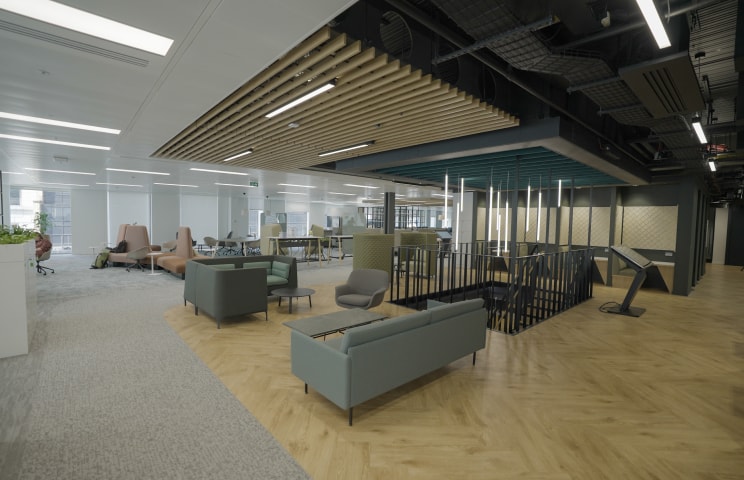
Sensors continuously monitoring the environment not only maintain air quality and thermal comfort for workers but cut energy and water consumption when spaces are unoccupied. The system can cut energy needed for heating, ventilation and air‑conditioning by 21%
Building intelligence capability is based on a unified suite of apps, including environment and utilisation sensors, digital access control, a branded visitor management system, and apps for mobile and digital signage. Desk booking systems are touch-free, and systems also support the ability to control individual temperature and light settings in enclosed spaces. Taken together, the technology helps the occupant to optimise space, save on energy and maintenance costs, and improve health, wellbeing and productivity for its people. Arcadis itself undertook the role of master systems integrator, working collaboratively with the main contractor, building manager and product providers.
The building intelligence system enables Arcadis to optimise energy use and maintenance activity, reducing operational impacts. Sensors continuously monitor the indoor environment and help cut energy and water consumption, responding to when areas are unoccupied. Simultaneously air quality and thermal comfort sensors regulate the environment, ensuring that people are comfortable in the workplace. Taken together, the system can cut energy needed for heating, ventilation and air-conditioning by as much as 21%, and through the use of an advanced dynamic lighting system can reduce lighting energy by 70%.
80Fen was commissioned as one of London’s first post-covid workplaces. The focus is on providing a sustainable workplace that enables staff to work in the way that best suits them. Building intelligence is a key component of the workplace strategy that is already delivering returns through effective workplace utilisation, even as office use increases post lockdown.
06 / Procurement and collaboration
Intelligent building procurement differs from a typical office fit-out because of the additional integration work needed between fit-out and the base-build systems and between the various products and systems featured in the smart building scope. Much digital workplace technology can be procured as standalone products, such as environmental conditions sensors or smart lockers. Knitting the systems together is currently the task of a master systems integrator (MSI).
MSIs are service providers that have domain expertise in IT systems, networks, building automation and controls, application software analytics, and support services. An MSI can design and programme the complex and interoperable cross-system integration of the base build, tenant systems and devices and web-based products. As market maturity and service expectations are highly variable, it is vital that a client’s scope of works is clearly defined, and that the appointment is embraced as a collaborative partnership.
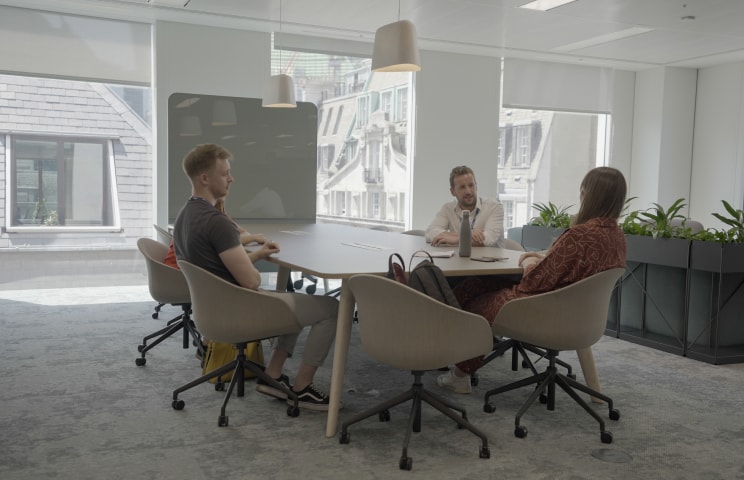
Few fit-out contractors currently possess this integration capability, which is offered mainly by consultants with a building services and building technology background. Agents are also developing propositions in this area as part of a one-stop-shop proposition.
However, with the technical capability in short supply, clients do need to be very careful in selecting their integrator. In time, standardised solutions will emerge along the lines of packaged audiovisual systems. However, while clients do have the freedom to select best-of-breed products, they also are highly reliant on the performance of the MSI to deploy them in a way that is flexible and resilient, anticipating the deployment of a roadmap of new features.
Inevitably this means that the MSI will be working closely with many specialist subcontractors under the main contract as well as with the client’s independent digital product providers. This requires careful co‑ordination and plenty of investment in the development of effective collaborative working by the key players.
The risk profile associated with digital system integration works also differs from a typical fit-out contract, with the MSI often operating as a partner rather than as a service provider working to a fixed lump-sum contract. Systems are much more complex than a typical building controls installation, with many more data feeds and control interfaces. Similarly, bringing together new combinations of products will introduce new sources of uncertainty. Proactive change management is very important in keeping programmes on track – ensuring that there is sufficient programme duration for all-important configuration, testing and commissioning works. Beyond handover, clients should anticipate an extended period of post-occupation configuration so that building systems can be adapted to how they are used in practice.
07 / Change management
An additional and vital non-fit-out element of a digital workspace implementation is active change management, aimed at delivering the target business benefits. Change management will focus on aligning people to the purpose of the change, highlighting the need to change learned and unlearned habits in the workplace and the countering of blockers.
Office moves have always been a critical opportunity to drive change into an organisation, reinforcing messages about how the organisation is evolving and how the workplace is supporting this evolution. For a technology-driven change, there is also the need to deliver a volume of training at speed, so that all users can effectively use new systems.
Key elements of a change programme will include:
- Communication – creating momentum towards the end destination and explaining how the change will work.
- Training – interventions needed to change behaviours and to develop new skills.
- Confirmation and recognition of improvements evidenced by surveys and user feedback.
- Benefits realisation – a broadly based plan to ensure that all sources of benefit are considered and tracked as part of the implementation.
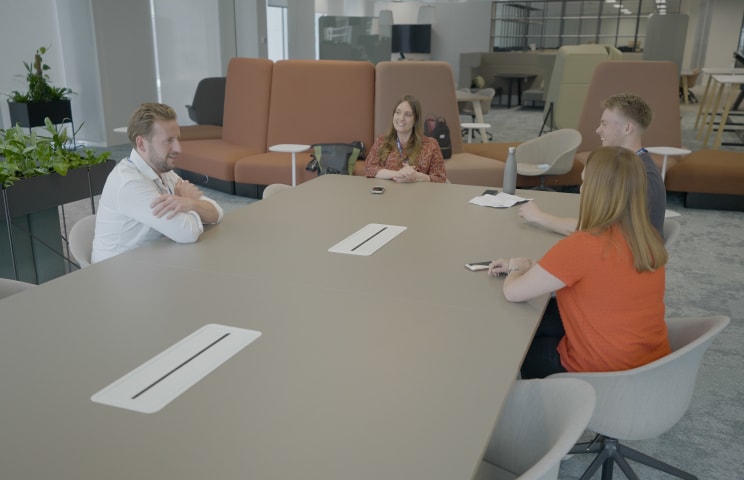
Employee engagement is central to the change management process and should be undertaken in a number of direct and subliminal ways. Presentations broadcast clear messages, while the questions in surveys can be used to subtly introduce change ideas as part of the consultation process.
The change culminates in a focus on new behaviours in the workplace. This has been difficult to do during covid, while office occupancy has been low, but will be a priority as activity levels increase. In practice, the deployment of these technologies will support and encourage increased activity levels.
Business change is always a challenge. Change involving building intelligence is particularly complex, given the combination of the technology learning curve and changed behaviours. Feedback and early action to identify and resolve issues and disciplined, consistent communication will support successful implementation. By contrast, by assuming that change is understood, or that enough communication has been delivered, otherwise well-founded programmes can be undermined.
08 / Conclusions
The implementation of building intelligence should focus on people rather than technology – so the solutions should be easy to use and beneficial. Apps also need to be “cool not creepy” – data collection, for example, needs to be undertaken in ways that build confidence rather than fuel suspicion.
A well-managed business process is needed to deliver the right outcomes, focused on user journeys and use cases to ensure the products being acquired are aligned to the business vision and will deliver the required benefit. Building intelligence is developing fast, but it has to be applied within base buildings with variable data and network capabilities. Integration still involves many one-off challenges, so a disciplined approach to delivery is very important if time and cost targets are to be met.
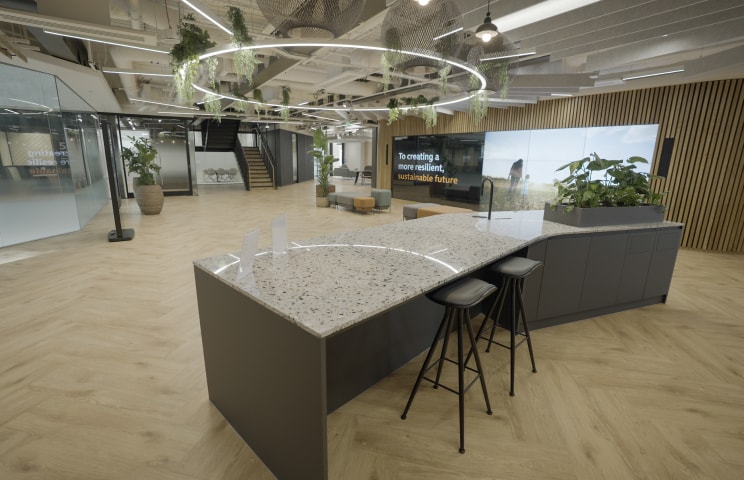
Technology is also evolving fast, with many solutions now accessible as cloud-based apps. This will potentially enable a try-before-you-buy model of service enhancement. Building intelligence is enabling the workplace to enter the continually upgraded world of digital, allowing it to adapt to meet ever more ambitious corporate ambitions in terms of user experience, environmental footprint and business performance.
Smart Buildings: the digital workplace was first published in Building Magazine on 11th March 2022. Building Magazine operates a paywall.
Contact Simon at simon.rawlinson@arcadis.com





